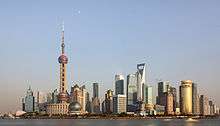Shanghainese people
|
| |
| Total population | |
|---|---|
| approximately 20,000,000 | |
| Regions with significant populations | |
| 14,000,000 people | |
| As part of Mainlander population | |
| As part of Mainlander population | |
| As part of Chinese American population | |
| As part of Chinese Australian population | |
| Languages | |
| Shanghainese dialect, other Wu Chinese dialects, Mandarin Chinese | |
| Religion | |
| Predominantly Mahayana Buddhism and Chinese folk religions (including Taoism, Confucianism, ancestral worship and others), with many non religious. Minority: Christianity | |
| Related ethnic groups | |
| Wuyue people, Ningbo people, other Han Chinese | |
The Shanghainese (Chinese: 上海人, p Shànghǎirén; Shanghainese: Zaanhening, [zɑ̃.hé.ɲɪɲ]) are the people of Shanghai, China.
The Old City of Shanghai was a minor settlement until the later Qing Dynasty and many districts of the present municipality of Shanghai originally had separate identities, including separate dialects of Taihu Wu. In recent decades, millions of Chinese have moved to the city, both as internal immigrants and as migrant workers. The 2010 Chinese census found 9 million of Shanghai's 23 million residents (almost 40%) were migrants without a Shanghai hukou, triple the number from the year 2000 census. These "New Shanghainese" (新上海人) are generally distinguished from the Shanghainese proper.
The term "Shanghainese" may thus apply to several different groups of varying exclusivity. Legally, it refers to those holding a hukou for one of the local governments in the municipality of Shanghai. Culturally, it most often means those who consider Shanghai to be their hometown, although this is sometimes restricted to those in the central districts or who speak the Shanghainese dialects of those districts (as opposed, for example, to the unintelligible subdialects in Jinshan).
Shanghainese diaspora
Although Shanghai was long a cosmopolitan city as one of China's treaty ports, it was not connected with the large-scale emigration seen in Fujian and Guangdong. Maritime commerce did, however, create a Shanghainese community in Hong Kong.[1][2] These Shanghainese or their forebears fled Mainland China prior to its occupation by the Communists in 1949. Some actors on the TVB network, a television network based in Hong Kong, are originally from Shanghai, such as Liza Wang, Tracy Ip, and Natalie Tong.
More recently, appreciable numbers of Shanghainese have migrated to other countries. There is a significant Shanghainese community in Sydney, Australia, particularly the suburbs of Ashfield and Burwood. Less prominent communities exist in the Chinatowns of other large metropolitan areas such as New York and Los Angeles in the United States.
Unlike many immigrants from Fujian and Guangdong, who predominantly occupy Chinatowns due to visible struggles with assimilation, many Shanghainese immigrants tend to integrate more successfully into society due to their tendency to have higher educational and socioeconomic statuses and international exposure than their counterparts from Fujian and Guandgong. Many Shanghainese tend to view Chinatowns as a humiliation and a symbol of integration failures. Because of this, they tend to try and distance themselves from them, with the exception of dining and commerce.[3][4]
Notable People
Shanghai is home to many outstanding and well known athletes such as Yao Ming, Liu Xiang, Wang Liqin, Wang Yihan
See also
References
- ↑ Burton, Sandra (1999-09-27), "Exodus of the Business Class", Time, retrieved 2011-10-06
- ↑ Goodstadt 2010, p. 208
- ↑ Personal first-hand interview with Shanghainese immigrants; one a retired doctor and one a statistician with a Ph.D from Duke
- ↑ Farrer, James. “‘New Shanghailanders’ or ‘new Shanghainese’: Western Expatriates’ Narratives of Emplacement in Shanghai.” Journal of Ethnic and Migration Studies 36.8 (2010): 1211–1228. Web.






